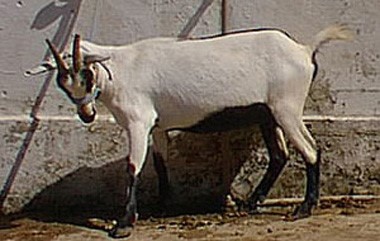Moxotó goats, native to northeastern Brazil, are meticulously bred for their remarkable resilience in the region's harsh semi-arid climates. Sporting a distinct white or cream-colored coat adorned with striking black face-stripes, back-stripes, and belly markings, their appearance serves both functional and aesthetic purposes.
Bred for their ability to thrive in challenging landscapes with limited access to water and vegetation, Moxotó goats are highly valued for their adaptability. They excel at foraging for sustenance even in adverse conditions, making them indispensable assets to local farmers and communities.
In addition to their hardiness, Moxotó goats make significant contributions to the livelihoods of many families in the region. While their milk production may not rival that of some dairy breeds, it is highly regarded for its quality and flavor. Similarly, their meat is prized for its tenderness and taste.
While meat production is their primary purpose, Moxotó goats also contribute to milk production to a lesser extent. Although they are not specifically bred for hair production, their hides may be utilized for leather goods in certain traditional practices. As such, they offer secondary benefits beyond meat production.
Furthermore, Moxotó goats play a crucial role in sustainable agriculture practices due to their relatively low maintenance requirements compared to other livestock breeds. Their ability to thrive on sparse vegetation and withstand droughts contributes to the region's agricultural resilience, providing economic stability and food security to local communities.
In essence, Moxotó goats are bred not only for their striking appearance but also for their invaluable contribution to the resilience and sustainability of agriculture in northeastern Brazil. Through their adaptability and hardiness, they embody the spirit of survival and adaptation in challenging environments, making them an integral part of the region's cultural and agricultural heritage.
